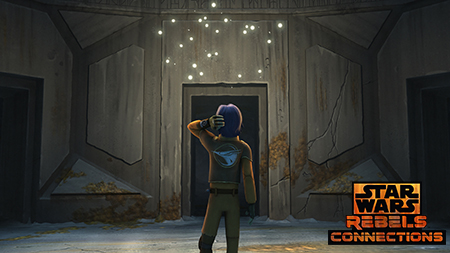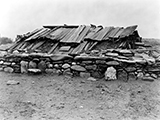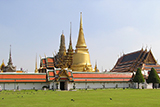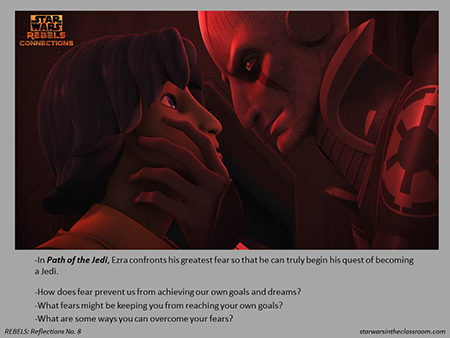 | Path of the JediSeason 1, Episode 8 | Gathering Forces | Path of the Jedi | Idiot's Array |

Recognizing it's time for Ezra to undertake his next important step in Jedi training, Kanan and his apprentice quest for an ancient Jedi Temple on Lothal. Once there, Ezra begins a series of Jedi tests and receives some unexpected guidance from Jedi Master Yoda.
|
Star Wars Rebels: "Yoda’s Guidance" | Star Wars Rebels: "Nothing and Everything" |
Where we had thought to travel outward, we shall come to the center of our own existence. And where we had thought to be alone, we shall be with all the world. --Joseph Campbell |
Vision Quests
In Path of the Jedi, Kanan takes Ezra to a long forgotten Jedi Temple far away from the bustling cities on Lothal. It is here that Ezra will face challenges or visions that will determine whether or not he is truly ready to be trained as a Jedi. In the story, Kanan encourages Ezra to find their destination using the Force. During meditation, Ezra has a vision of the old Jedi Temple and then directs them to the temple’s location.
Once inside the temple, Ezra discovers that he must complete his quest through the derelict sanctuary on his own, without the aid of his master, Kanan. After numerous trials and failures, the voice of Master Yoda speaks to Ezra who eventually comes to grip with his true fear of being alone. The Force then guides him to a room where he is presented with a Kyber crystal. Ezra returns to Kanan, who is pleased and surprised to see that his padawan found a lightsaber crystal. After several days, Ezra completes the construction of his own lightsaber, marking another important step in his Jedi training.
Ezra’s journey within the temple is reminiscent of the spiritual vision quests found in many Native American cultures. This rite of passage marked the transition when a child reached adulthood. In a vision quest, a young man would purify his body in a sweat lodge, spend several days fasting, and then be taken far away to a sacred wilderness location where they would be left alone for up to four nights.
During a vision quest, the “quester” would not eat or sleep as he wandered around the wilderness searching for his vision. Instead, they would rely on their strength of spirit to see them through the quest. To acquire the vision they had to give up all of their earthly desires (much like Ezra acknowledging his fear of being alone). Ultimately, the vision would come in the form of a sacred animal or force of nature.
After several days, the “quester” would return to his village and meet with a medicine man who would help him understand his vision. After completing a vision quest the child becomes a man by taking responsibility for his own actions and making greater contributions to the tribe or society. In the end, the vision determines the path that will be followed for the rest of that individual’s life.
One of the best known examples of a vision quest comes from the Lakota Sioux tribe. Their vision quests were known as Hembleciya, which translates to “crying for a dream.” The word refers to the “questers” inward and outward crying as they search for their vision and ultimately what will guide them for the remainder of their life.
The Jedi, The Sith, Kanan Jarrus, Ezra Bridger, The Inquisitor, Yoda, Jedi Temple (Coruscant), Kyber Crystal
- Wisdom of the Elders: The Wanderer: Vision Quest
- Yellow Wolf: His Own Story- Excerpt about his vision quest
- What Is a Vision Quest and Why Do One? By: Maddisen K. Krown
- Obtaining the Weyekin
- Weyekin stories. Titwatit Weyekishnim (1911) By: JM Cornelison
Pilgrimages
In this episode, Kanan and Ezra venture far from civilization to an ancient Jedi Temple. It is here that both Master and Padawan will receive guidance from the Force. Kanan will question his own past and ability to train a padawan, while Ezra discovers his own path to becoming a Jedi.
Pilgrimages or holy journeys to sacred places have been traditions of many ancient and contemporary cultures and religions. During pilgrimages, people often seek spiritual guidance. The journey to a holy place typically involves long periods of reflecting upon oneself and communing with a spirit or deity. Often, the sacred places for pilgrims are believed to be locations where important religious figures were born or died, miracles were performed, or a place where the spirit of a deity exists. Many of these locations are commemorated with temples or shrines.
For some religions, pilgrimages are sacred rites that must be fulfilled by practitioners. For example, able bodied Muslims are expected to participate in the Hajj or pilgrimage to Mecca at least once in their lifetime. For other religions, pilgrimages serve as an individual choice where a person has chosen to go on their own spiritual journey. In all of these journeys, believers hope that their visit to a sacred place will provide them with guidance or a renewed closeness to their faith.
Currently, the world’s largest pilgrimage is the Kumbh Mela of the Hindu faith. Every three years millions of Hindus venture to one of four Indian cities to bathe in a sacred river. In 2013, an estimated one hundred million people traveled to Allahabad where they participated in the pilgrimage. It is believed that bathing in these rivers cleanses one’s soul of sin.
The Jedi, The Sith, Kanan Jarrus, Ezra Bridger, The Inquisitor, Yoda, Jedi Temple (Coruscant)
- BBC: Pilgrimages and miracles
- Spartacus Education: Medieval Pilgrimages
- Huffpost: Religious Pilgrimages: 14 Of The World's Most Spiritual Destinations
- EDSITEMENT! Lesson: Trekking to Timbuktu: Mansa Musa Takes a Trip
- EDSITEMENT! Lesson: Chaucer's Wife of Bath
Significance of Temples
As mentioned above, Kanan and Ezra venture to a long forgotten Jedi Temple on Lothal. It is here that they will look deep within themselves as they seek guidance from the Force. Jedi Temples are usually found in areas where the Force has a strong presence. At such temples and shrines, Jedi are afforded a stronger connection to the Force.
In our world, people often seek out temples that house a deeper meaning to their faith and spiritual journey. Temples often mark the locations where important religious figures were born or died, miracles were performed, or a a place where the spirit of a deity is believed to exist. For many, temples are where the human and divine realms come together allowing the two (human and god) to interact.
In seeking out a temple, religious practitioners often find sanctuary, guidance and answers to questions that trouble them. Many of our temples are thousands of years old, like the Ziggurat of Ur which was originally built in the 21st century BC to honor the Mesopotamian moon god, Nanna. Although this temple no longer serves a religious purpose, it stands as a reminder of humanity’s lengthy quest for answers and spiritual guidance. Other ancient temples, like the Temple Mount in Jerusalem, continue to serve an important and controversial role for many contemporary religions.
The Jedi Temple visited by Kanan and Ezra most closely resembles the appearance of Buddhist temples known as pagodas, wats, or stupas depending on one’s region. These religious structures are sacred and represent the purity of the land it is placed upon. Each temple is designed to promote an individual’s inner and outer peace, much like a Jedi Temple.
The Jedi, The Sith, Kanan Jarrus, Ezra Bridger, The Inquisitor, Yoda, Jedi Temple (Coruscant)
- EDSITEMENT! Lesson: Angkor What? Angkor Wat!
- Scholastic: Temple in Tikal: Ancient Architecture
- Teachers Network: A Temple Fit for a God(dess!)
- The British Museum: Ancient Egyptian Temples
Finding the Light in the Darkness
In Path of the Jedi, Kanan and Ezra go on a quest for knowledge. To complete this journey, they seek out a Jedi Temple located far away in the outer regions of Lothal. Ezra is tasked with entering the temple alone to discover whether or not he is to be trained as a Jedi.
Once inside, Ezra immediately struggles with doubt and watches as an apparition of Kanan is killed by the Inquisitor. Filled with a sense of vengeance, Ezra confronts the Inquisitor only to be defeated and knocked off of a high cliff. He awakens to find himself in the Ghost where he witnesses the murder of his friends, once again at the hands of the Inquisitor. Finally, after falling into another abyss, Ezra is again confronted by the Inquisitor. Just as the Sith prepares to mortally strike the young Jedi, Ezra recognizes his true fear of being alone. The Inquisitor’s blow fails to harm Ezra, revealing he has passed his trial.
In mythology, heroes must often face and defeat their own fears before they can begin their true journey. For many heroes this journey may be a quest for knowledge, saving friends and family or fighting for a greater cause. Ezra’s challenge in the Jedi Temple was to uncover his fear so that he could begin his true quest of becoming a Jedi. Had he failed to uncover this fear of being alone, his pathway to becoming a Jedi would remain blocked.
As Joseph Campbell said, “at the bottom of the abyss comes the voice of salvation. The black moment is the moment when the real message of transformation is going to come. At the darkest moment comes the light.” This idea holds true for Ezra. Only when faced with the loss of his friends and his own imminent death does he recognize his truest fear. In his darkest moment Ezra found the light he had been searching for. Although many challenges remain for Ezra, he has proven to himself and Kanan that he is ready to begin his journey of becoming a Jedi.
The Jedi, The Sith, Kanan Jarrus, Ezra Bridger, The Inquisitor, Yoda
Gathering Forces | Path of the Jedi | Idiot's Array
First posted on: December 30, 2014










